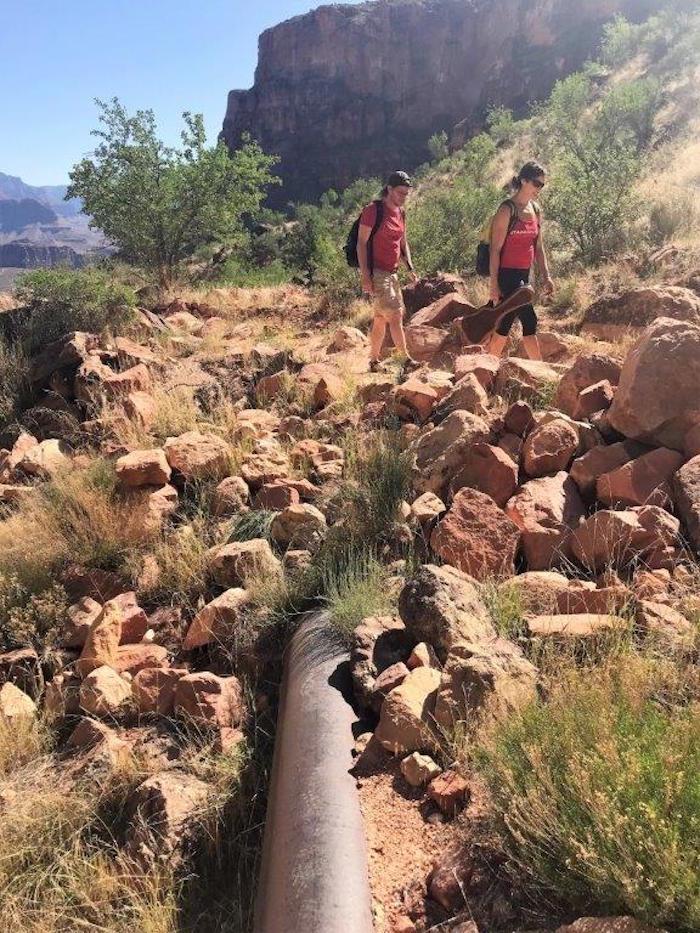
Grand Canyon hikers pass an exposed section of the obsolete Trans-Canyon Pipeline at the park/Rita Beamish
GRAND CANYON NATIONAL PARK – The sun bore down on Indian Garden where a light breeze soothed a dozen or so hikers resting and filling water bottles from a pipe spigot, oblivious to the quiet thrum of machinery from a modest stone structure just off the trail.
Debarshi Das and his wife Sarah Courtney of Long Beach, Calif., were among the springtime trekkers heading to the majestic canyon’s South Rim, still another 3,000 feet and 4.5 switch-backing miles up the Bright Angel Trail. They paid no heed to the stone pumphouse, part of the pipeline system running from a spring below the North Rim, down across the Colorado River rapids, and up here to Indian Garden where the water is pumped on up to Grand Canyon Village at the South Rim.
It was news to them that the 16-mile pipeline, sole water supply for the tourist-blanketed village, is in terrible shape -- a symptom of the nearly $12 billion maintenance backlog across the U.S. National Park system.
“It’s a national park. There’s an assumption that things work well, that facilities you need are in good shape,” Das said.
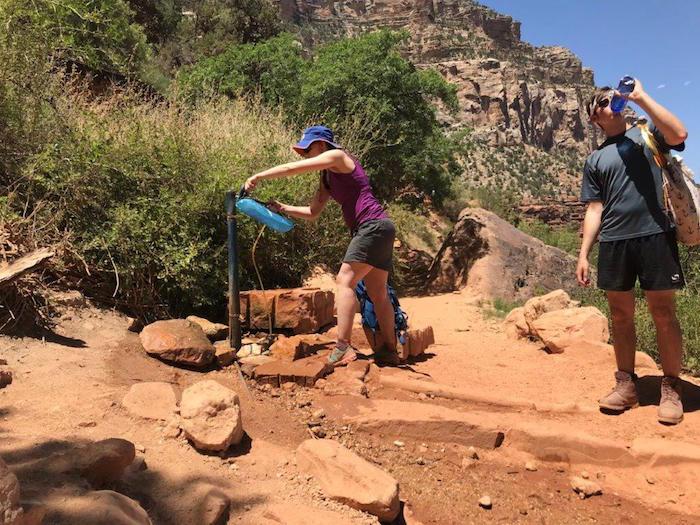
Water for hikers in the Inner Gorge of Grand Canyon is provided via the Trans-Canyon Pipeline/Rita Beamish
In fact, leaks from the 1960s-era pipeline, from dribbles to arcing sprays, threaten the water flow for 6 million annual park visitors, not to mention for fire suppression for hundreds of historic and other park buildings. Conservation is now a way of life, even at times requiring shower restrictions, trailhead spigot shut-offs, and meals to be served on paper plates with plastic utensils.
The pipeline exemplifies the National Park Service’s struggle to keep visitors and staff safe while staggering under the maintenance backlog: crumbling roadways built for another era, weakened roofs and moldy walls, storm-blasted docks, and things as simple as faded reflective tape and signs needed for tunnel safety.
It’s not a new story, but one that grows more dramatic year by year as park operating budgets fall behind annual upkeep at the same time as visitor numbers escalate.
“I’m shocked this water coming from the North Rim is what this whole tourist economy is dependent on,” said Courtney. “It’s really important.”
Not important enough, however, to get Washington’s attention for more than superficial patching as visitor numbers doubled from the 1980s. The environmental review process at Grand Canyon National Park now is underway to replace the 6-inch aluminum pipe with an 8-inch steel line and upgrade the pump system. Pricetag: between $70 million and $120 million, and the Park Service in its 2019 budget proposal is asking Congress for the first $14 million.
The agency’s efforts “to sort of hold things together with duct tape, if you will,” are not sustainable long term, nor is delaying the projects, said John Garder, senior director of budget for the nonprofit National Parks Conservation Association. “Eventually they will pose a threat to the safety of visitors and park staff. Congress needs to recognize these things can’t wait forever before something bad eventually happens.”
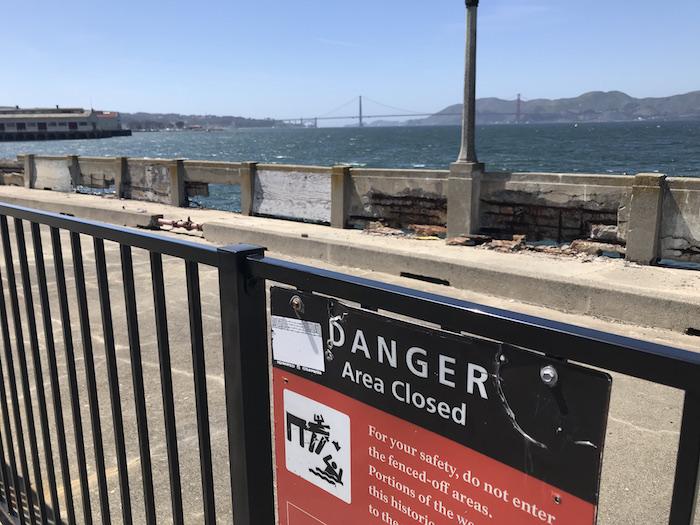
Deteriorating walls at San Francisco Maritime National Historical Park prevent visitors from getting close to San Francisco Bay/Rita Beamish
Risky Business
Safety implications are a tricky topic across the 417 sites of the National Park System: Certainly the natural world, especially in backcountry, holds inherent risks. No one expects railings around every cliff edge, and in less-remote areas officials say they address hazards quickly or block public access.
“Any known safety hazard, we try to mitigate, and if we can’t mitigate it, we have to close it,” said Brad Shattuck, maintenance chief for the parks’ Southeast region, where ferocious storms last year were the last straw for many older roofs and docks, including some used by law enforcement boats.
The Park Service’s budget proposal for maintenance priorities nonetheless contains a litany of safety worries, from earthquake and fire risks to decrepit sewage systems, shoulder-less roadways and worn out sea walls.
Park documents and interviews with officials reveal the scope:
- Abandoned mines that once yielded metals, coal, and minerals hold risks of falls, noxious gas exposure, and environmental hazards. The Trump administration proposes $4 million in 2019 to remediate some of them.
- Historic Fort Mason’s pre-1940 electric system serves up regular power outages to organizations now housed in this part of Golden Gate National Recreation Area on the San Francisco Bay.
- Flammable fiberboard, hazardous wiring, and other dangers at the Chateau Lodge at Oregon Caves National Monument will force its closure later this year for an estimated $20 million renovation, thanks partly to financial contribution from the state.
- Parks across the country need communications systems upgrades, including Zion National Park, where law-enforcement equipment was upgraded to communicate with the sheriff’s department, but radios and communications for other park workers are on the backlog list.
Grand Canyon’s pipeline system again failed this year in the run-up to the spring break visitor crush. Unable to keep up with demand while crews repaired it, said Kris Provenzano, project manager for the upgrade, “the park had to go into restrictive water measures to ensure they had water for fire supression and public health.”
South Rim restaurants used disposable instead of washable plates. Camper and RV services were curtailed.
When it comes to roadways, the parks face mile after mile of maintenance needs, with roads, bridges, and parking lots accounting for more than half the overall $12 billion backlog.
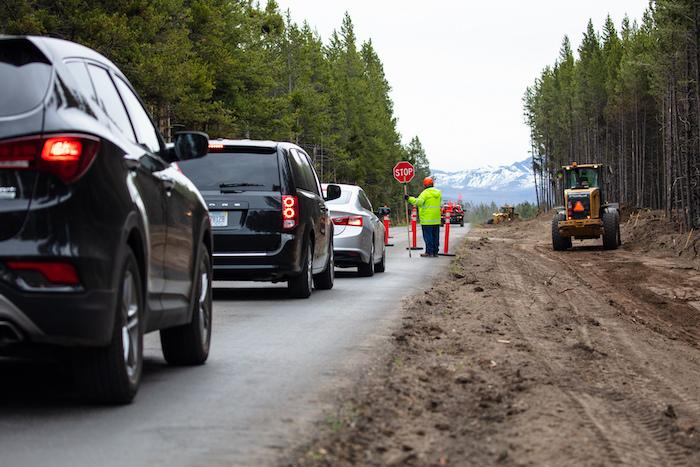
Road repairs in Yellowstone National Park are never-ending/NPS, Jacob W. Frank
“We are worried for safety,” said Dan Wenk, superintendent of Yellowstone National Park. “We’re still dealing with a lot of 20-foot road (stretches) with no shoulders or correction areas,” if cars slip off the pavement edge, he said.
As well, said Wenk, Yellowstone’s other maintenance needs include “abysmal” conditions in employee housing, particularly trailers used since the 1950s and '60s, with mold, and “rotten siding and floors.”
Wasting Away
In the uninspiring underbelly of the parks, few safety issues are as crucial as wastewater systems and the health implications if waste is leaked or spilled. Overburdened and outdated systems face $270 million worth of deferred maintenance, the Park Service says. Water systems, like Grand Canyon’s Trans-Canyon Pipeline, are behind to the tune of $420 million.
It’s a never-ending game of catch-up in Everglades National Park where Deputy Superintendent Justin Unger says water and wastewater systems dating to the 1950s are regularly battered and corroded by storms and salt-water surges, even as the park works to modernize them in between.
“We get frequent breaks that lead to boil-water situations. It does affect park visitors,” Unger said. “We’ve spent quite a bit in overtime just trying to maintain our systems.”
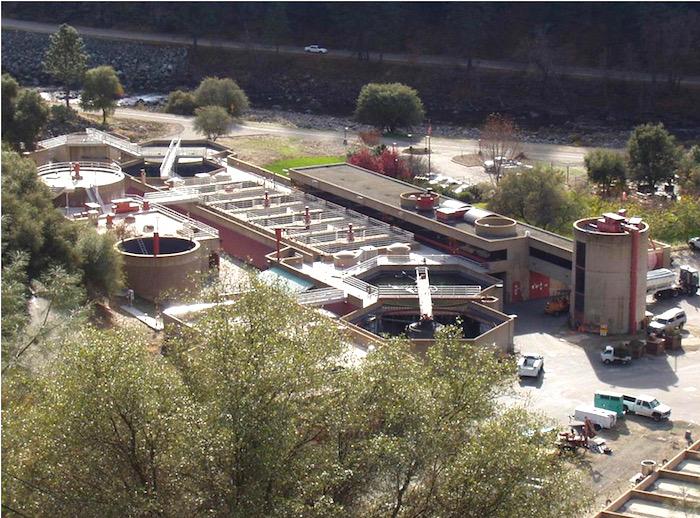
Tens of millions of dollars are needed to repair and upgrade Yosemite National Park's El Portal Wastewater Treatment Plant/NPS
At Yosemite National Park, the obsolete Wawona Wastewater Treatment Plant, no longer adequately processing solid waste, sends daily truckloads of sludge to another park plant. Worried about potential pathogen-laden waste and biproduct spills, the Park Service recently received nearly $25 million for an upgrade. Deteriorated restrooms also are a concern for public sanitation, disease prevention and protecting water quality – as well as a major source of visitor complaints, park officials say.
And the catchment water system at Hawai'i Volcanos National Park, dating to 1929 – with worn-out tanks and pipes to prove it -- needs some $5 million in needed rehab work. “We capture the water at the summit from the clouds. It’s our only water source,” said park spokeswoman Jessica Ferracane.
Difficult choices
With weak budgets forcing unending Sophie’s Choices for limited funding, shutdowns often are the only option for safety.
That means visitors for more than a decade have been missing out on one of the best views of Yellowstone’s Tower Fall after a mudslide wiped out the base trail in the early 2000s. “We haven’t had the resources to do it,” Wenk said.
At Zion, the middle section of the park's lush Emerald Pools trail, was closed nearly eight years ago by a rainy landslide that left a precarious hiking zone. Only with help from the nonprofit Zion Forever organization and a charitable donation arranged by the National Park Foundation is a rebuilding project taking shape.
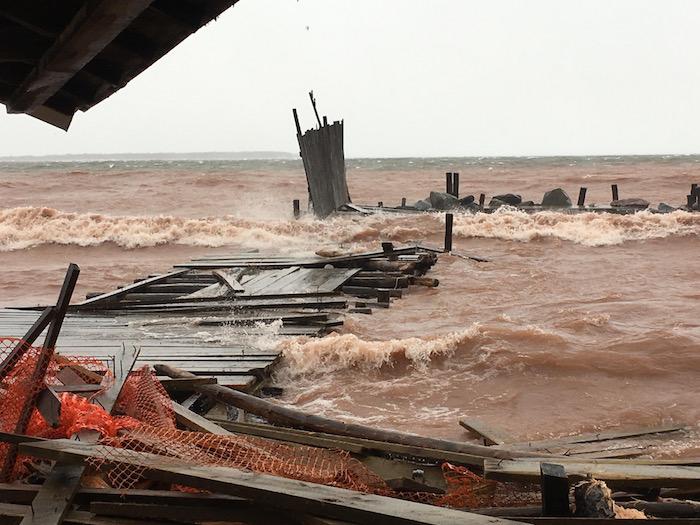
The historic dock at Little Sand Bay in Apostle Islands National Lakeshore in Wisconsin was battered by storms last fall/NPS
At Apostle Island National Lakeshore, a 2012 inspection found Little Sand Bay visitor center uninhabitable due to mold, rodent feces, and oil contamination below. “The mold was a symptom of huge structural problems,” in the 1940s-era building, park Superintendent Bob Krumenaker explained. After a few temporary fixes, he said, the health and safety issues allowed the park to secure $2 million to replace it sooner than might have otherwise occurred.
Even when backlogged projects do get money, Krumenaker said, “We don’t have enough people to keep up with the maintenance we have” day to day, a key issue that keeps the backlog growing. And employees eager to fix things sometimes push the edge of their own safety in harsh weather, he said. “We are close to a period of reckoning here -- we simply can’t continue to maintain.”
Ramifications of Washington’s short-sightedness can hit close to home. Almost within earshot of political warring under the Capitol dome, water infiltration got so bad at the Jefferson Memorial that a five-foot chunk of limestone ceiling fell out in 2014. Protective mesh still covers the ceiling, with roof repairs approved on the to-do list for later this year.
This decay afflicts an agency whose mission is to safeguard the nation’s most treasured places for future generations. As Congress bandies about proposals to find government dollars, Phil Francis, president of the Coalition to Protect America's National Parks and a former Blue Ridge superintendent, advised, “Visitors to national parks have got to start speaking up … to let their Congress members know that the parks are important.”
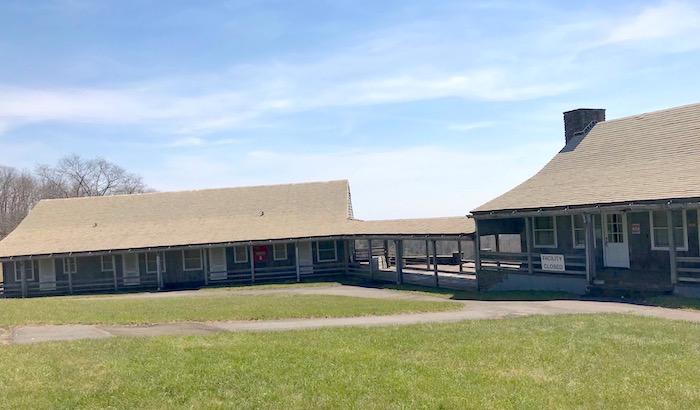
Not only is the Bluffs Lodge along the Blue Ridge Parkway closed due to lack of a concessionaire, but it has been overrun by mold that poses a threat to anyone who enters/NPS
Assets in Jeopardy
On a sunny day this spring, tourists and locals biked, scootered and pushed strollers on the recreation pier that curves 1,400 feet out over San Francisco Bay. Stunning views of the Golden Gate Bridge and Alcatraz could be had -- some framed by gaping holes in the cement guardrail where human-sized concrete chunks were missing.
With no sign of the $70 million needed to fix the crumbling pier, the San Francisco Maritime National Historic Park has installed a metal-rung fence, bisecting the pier lengthwise, to deter people from the holey side. “Sometimes when the fishing’s good, people will go around the fence and fish there,” shrugged a local cyclist.
The pier is closed for safety when big events draw huge waterfront crowds. Ultimately, said public information officer Lynn Cullivan, it may have to close permanently.
Against this backdrop, Congress struggles to find a solution, while the National Park Service relies on its maintenance wizards to make do with insufficient resources.
Support for this reporting was provided by The Pew Charitable Trusts
Previous articles in this series:
Traveler Special Report: Closing The National Park System's Maintenance Backlog
Traveler Special Report: Some Friends Groups Asked To Provide "Margin Of Survival"
Traveler Special Report: Maintenance Woes Blocking Access To Parts Of National Park System
Traveler Special Report: Historic Sites And Structures Affected By Maintenance Backlog
Traveler Special Report: Antiquated Wastewater, Sewer Facilities Go Wanting In National Parks



Comments
We just hiked the Norris Gyser trail in Yellowstone last week and could not believe the condition of the boardwalk and trail. Broken boards or holes in the walkway--rotted perimeter logs with big nails sticking out. Loose boards and signs so old you could hardlyeven read them. It's a real disgrace when you think of Yellowstone as the "jewel " in the crown of our National parks. Wonder what all the tourists from other countries thing?? Its was really quite shocking .
i hope the recent reports on a bipartisan deferred maintenance bill come to fruition. Funding is a huge issue - but so it proeject execution. The NPS does not do small things well (hiring systems are broken and no leadership has been found to fix it; Contracting processes are so over the top cumbersome and gum up the system that basically the agency's acquisition process is an obstacle to getting anything done; compliance processes such as getting HUD (that is right, Housing and Urban Development) to sign off on any NPS demolishion of a structure. It all wastes time and money and it saps the employees energy and motivation. Maybe tackling the deferred maintenance can be the one thing that transforms the NPS on how it gets Things done .
But Mather, how many of the things that gum up hiring, contracting and so many other aspects not only of NPS operations, but of virtually every other agency direct results of actions mandated by Congress as members play political games or try to please all of their contributors?
Lee. I think the obstacles in front of the NPS ability to get things done are more a product of stove-piped agencies and less about pleasing contributors. For example, in order to demolish a structure the NPS must comply with a HUD law from the 1980s (McKinney Act) which directs agencies to make their buildings slated for demolition available to the public for the potential use in solving the homelessness problem in the country. While a worthwhile goal, is it realistic to expect a structure in terrible condition from an NPS unit to be taken by a group and moved somewhere to provide housing for the homeless. The answer has been no - there is not one known instance of an NPS structure being used by anyone through the McKinney act process. But the agency has an entire process that takes time and money to BE ALLOWED to dispose of obsolete and irreparable structures. This is just one small example of how hard it is to just do the basics - hopefully someone can lead an effort to cure this agency of non-sensical processes like this one. Money can provide the resources to tackle the backlog but the archaic processes will remain unless they are dealt with at the same time. There are other processes in Human Resources and Contracting that make little sense but encumber the agency from getting things done.
I'm not familiar with the term "stove piped," but I think you may have just helped prove my point, Mather. Where did the McKinney Act come from? And from whence flow the regulations regarding Human Resources and Contracting?
Mather, that is exactly the kind of burdensome, expensive and ineffective legislation/regulation that Trump is getting rid of.
One has to wonder what the maintenance backlog would be without all the government bureaucracy. While often well intentioned, who in their right mind would work to eliminate their own department or position unless there is a incentive to do so? It is a failure of government and those creating new agencies to not properly define the goal and the measure of success. Welfare being the prime example. One side defines success in how many dollars are handed out each year while the other defines success in how few. Neither are that simple yet it is not that complicated either. In the end it is those who end up reliant on government that suffer the most.
Well, you are right WP in that it is not as simple as you describe. You are absolutely wrong if you think Welfare and those who are "on the dole" have anything to do with the maintenance backlog. Way to leapfrog from an NPS topic and into a right wing talking pioint. Poorly played, sir. Poorly played.